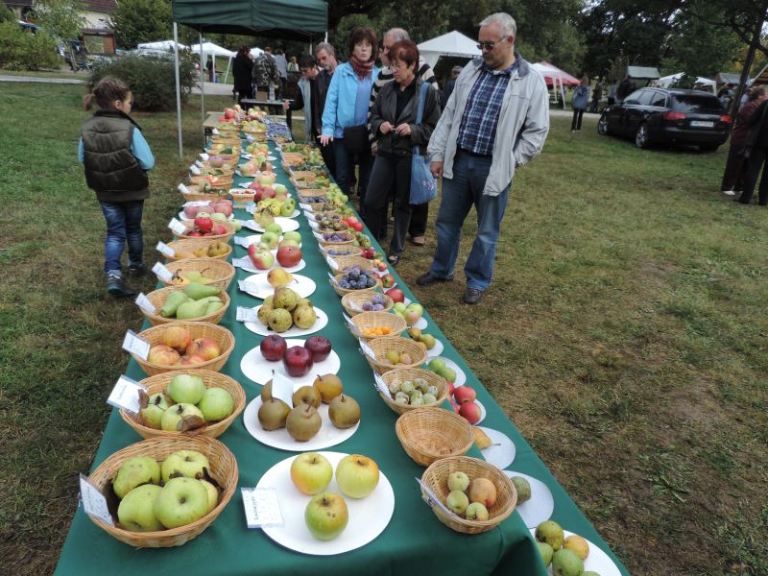Network of Orchardists of the Carpathian Basin

A network of volunteers sharing information and organising local regional and national programmes to train, provide study tours map old species and organise meetings of orchardrists of the Carpathian Basin.
Key words: Adaptive orchard management, fruit landraces
Short description
Name of the initiative? Network of Orchardrists of the Carpathian Basin
Country: Hungary*
Region: Carpathian Basin / Central Europe
What kind of initiative? Environment, Biodiversity, Community
*It is actually a transboundary network: our members work in Hungary, in Transylvania (part of Romania), the former Upper Hungary (part of Slovakia) and in the Vojvodina (part of Serbia)
The Story
Adaptive orchard management means adapting to the landscape and the natural endowment. An orchard managed this way is mosaic structured and has multiple levels, like natural ecosystems. The fruit trees in it are of diverse races, species and ages.
The adaptive orchard management is not only about fruits, but a lot of activities of small farmers, which are organically connected to the orchard. It is an interconnected system, an ‘ancient pattern’, in which animals have their places too, no matter whether they are livestock (poultry, pigs, cattle, horses, sheep etc.), or wild animals (hedgehogs, badgers, deer etc.), insects (e.g. bees, ants), reptiles (frogs, snakes etc.). Places, which are connected to the house of the family, like the kitchen garden, or even a lake can be parts of the orchard. The variety of food products (from raw fruits through processed fruits to meat products), and handcraft objects for storing, carrying (baskets, cases, felt objects etc.) produced here make it nearly a self-sufficient system. The primary aim is not commodity production, but ensuring self-sufficiency for the family or the community.
It is important that wood from the orchard (e.g. cut off branches from pruning) provides material for heating, helping to create energy-security of a small farm. It is a complex system working like old patterns, therefore it has a role in heritage preservation too.
The reanimation and promotion of this system is one of the most important part of our mission.
Thanks to the excellent natural features of the Carpathian Basin, it used to be a paradise on earth. The diversity of fruit races was an integral part of the diversity of wildlife. Today our old fruit landraces are endangered. ‘Adaptive Orchard Management’ means adapting to the landscape. It strives not only to save old species, but to reanimate and to propagate the approach based on cultivating landraces as well.
“We intend to save fruit landraces of the Carpathian Basin in situ or on farm.”
Our goal is to spread the ‘adaptive orchard management’ approach and its diverse activities. We intend to save fruit landraces of the Carpathian Basin in situ or on farm.
Our Network is not a legal person, though there are legal persons among our members. The network operates based on the voluntary work of its members. Its primary role is spreading information. Programs are organised by our members in the Carpathian Basin and are open for everyone: training offers orchard managers an opportunity to increase their theoretical and practical knowledge.
One of the concrete results is that there are more and more spots on the map of the Carpathian Basin, where programs related to adaptive orchard management, or exhibitions of fruit landraces, species are held. The number of interested people on our mailing list, in our Facebook group is constantly rising. There is an increasing interest in the landraces as well. We established a formal contact with the Forest Research Institute of the National Agricultural Research and Innovation Centre of Hungary.
In the future we hope to expand the Network as much as possible: involving new members, creating regional groups, and organisations, becoming widely known and recognised by the ‘official’ horticulture, fruit production sector professionals.

The modern man has forgotten much of the ancient knowledge that used to preserve culture. The 20th century (especially in Eastern Europe) strived to eliminate the organic, stable patterns of the middle age, like traditional orchard management too. Today, everything is about direct profit and money. Only expenditures and incomes (boosted with loans) matter. However, there have always been ‘fanatics’ (e.g. the grafting men of villages), who preserved and saved old species even in the upwind. In the past decade, partly thanks to our promotion work, the adherents of adaptive orchard management, and its social acceptance grew rapidly.
“In the beginning, we had no patterns of similar, previous activities. Some enthusiastic people just clubbed together and started to save and map old species.”
In the beginning, we had no patterns of similar, previous activities. Some enthusiastic people just clubbed together and started to save and map old species. Then, we started to organise professional trainings for ourselves and our followers. Then, we created our communication channels (mailing list, homepage, Facebook page etc.) in order to reach more people. Today, we organise several open days in the Carpathian Basin with various professional programs, species exhibitions and tastings. There have been several initiatives to change the relevant legal system in recent years too.
The ban of propagation of fruit landraces was replaced by a regulation, on how it can be made. Another initiative was started that a new land use category should be established, the ‘orchard grove’, but that process is still on the way.
The official ’horticulture’ or ’agricultural’ professions have watched our aspirations with reluctance up to now. With the emergence of new challenges (climate change, extreme weather, soil erosion etc.) there are more and more signs that they may try to establish cooperation with us in the near future. Our experiences can be directly used and may promote agriculture.
Additional Information:
http://gyumolcsesz.hu/ https://www.facebook.com/groups/gyumolcsesz
IN MEDIA UPLOAD IMAGE: Szétválogató-248.jpg
300-éves-almafa.jpg
Aggteleki-fajtabemutató.jpg
Drávefok-2006.-dec.-004.jpg
DSC03450.JPG
DSC05081.JPG
Gyümölcsész-poszter.jpg
Kaláka.jpg
